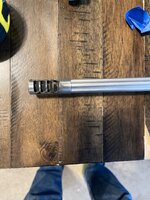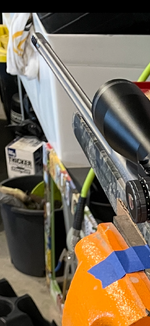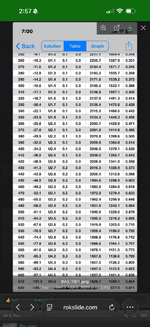Navigation
Install the app
How to install the app on iOS
Follow along with the video below to see how to install our site as a web app on your home screen.
Note: This feature may not be available in some browsers.
More options
Style variation
You are using an out of date browser. It may not display this or other websites correctly.
You should upgrade or use an alternative browser.
You should upgrade or use an alternative browser.
Is a 20 inch 6.5 PRC enough for elk?
- Thread starter ltfreeman11
- Start date
Snowhunter11
Lil-Rokslider
This Tikka 6.5 manbun was cut for a friend at 19” into the flutes. 1/2 x28 thread. Muzzlebreak not a can but you get the idea. After going deaf shooting an elk this fall he is now looking to buy a suppressor.Has anyone chopped into the flutes on a tikka roughtech D18 barrel to thread? I have a 24” roughtech 6.5 prc I may mess around with and cut to 20” for a can, just wondering if anyone has experience / what threading you got on there.
Attachments
Appreciate the reply - you know if that is that a superlite barrel or the roughtech / d18? Was hoping to get 5/8th into the roughtechThis Tikka 6.5 manbun was cut for a friend at 19” into the flutes. 1/2 x28 thread. Muzzlebreak not a can but you get the idea. After going deaf shooting an elk this fall he is now looking to buy a suppressor.
You will be fine for 5/8 on the Roughtech. I have a D-18 with the shoulder at the end of the flutes, because I'm OCD like that.Appreciate the reply - you know if that is that a superlite barrel or the roughtech / d18? Was hoping to get 5/8th into the roughtech
Snowhunter11
Lil-Rokslider
My bad I bet that is a superlite..Appreciate the reply - you know if that is that a superlite barrel or the roughtech / d18? Was hoping to get 5/8th into the roughtech
Tikka 6.5 creed factory cut to 18” suppressed. 630 yards to 1800fps. Hornady match 147gr factory ammo.
Kinda new to this. What are these numbers? How do you figure out what your bullets are doing?
Attachments
Not sure I'm reading this right. It's right there in your attachment, the velocity.Kinda new to this. What are these numbers? How do you figure out what your bullets are doing?
That’s was a screen shot from the original comment. So you just look at the velocity of your round at different yardages to see what the energy is ?Not sure I'm reading this right. It's right there in your attachment, the velocity.
WeiserBucks
WKR
Disregard energy, verify adequate impact velocity for bullet expansion.That’s was a screen shot from the original comment. So you just look at the velocity of your round at different yardages to see what the energy is ?
Ok how do you know what that is for the bullet you are shooting? Or how do you figure that out ?Disregard energy, verify adequate impact velocity for bullet
WeiserBucks
WKR
Most mfgs have a minimum recommend velocity for appropriate expansion. Other bullets are trial and error.Ok how do you know what that is for the bullet you are shooting? Or how do you figure that out ?
Oh sorry I thought you provided that shot. Specifically to these match bullets (TMK's, M's), through testing, many have suggested that 1800 fps is the minimum velocity for reliable performance. Manufacturers don't typically publish that info for match bullets as they're not intended for hunting, but you'll find info on hunting designed projectiles that's published for them. Energy is less relevant as long as you've got that 1800 fps speed you should be gtg with the RS approved projectiles.That’s was a screen shot from the original comment. So you just look at the velocity of your round at different yardages to see what the energy is ?
To figure out what that particular bullet is doing in your rifle you need to download a ballistic app, or use a ballistic calculator, and input live fire data from your rifle at the range.Ok how do you know what that is for the bullet you are shooting? Or how do you figure that out ?
Using the Hornady ballistics calculator on their website for example, you would input all the specs-
rifle: twist, scope height, bore diameter, zero range/angle.
load data: muzzle velocity, bullet weight, G1/G7 BC.
environmentals: elevation, temperature, pressure, humidity.
Then input the table parameters and it will spit out a spreadsheet. It will show you velocities at distances and you can determine what yardage your bullet falls below the recommended impact velocity based on the manufacturers recommendations, for that load at that set of environmentals.
Garbage in, garbage out. To get measurements like muzzle velocity you either need a reliable chronograph with a decent sample size, or actually shoot known distances and true up the velocity and BC based on impacts.
...then add at least 10%:Specifically to these match bullets (TMK's, M's), through testing, many have suggested that 1800 fps is the minimum velocity for reliable performance. Manufacturers don't typically publish that info for match bullets as they're not intended for hunting, but you'll find info on hunting designed projectiles that's published for them.
Hornady quotes 1,600 FPS for ELD-X. Most here use 1,800.
Hornady quotes 2,000 FPS for CX. Most here use 2,200 (though 2,400 makes a bigger hole).
If the manufacturer doesn't provide it, you gather data from threads like these that share wound channels with projectile details and estimated impact velocities:Ok how do you know what that is for the bullet you are shooting? Or how do you figure that out ?
DON'T HAVE TIME TO READ 176 PAGES? HERE'S THE CHEAT SHEET.
“Bullets matter more than headstamps.”
“Spent primers offer the supreme tutorial”.
I’ve read it here and elsewhere online. It got my attention. I started digging and asking questions and listened.
The 77gr TMK delivered by a .223 is where I ended up after many discussions and objective data regarding bullet performance and numerous pics of field results.
Now for the delivery system. Accurate. Repeatable. Reliable. Reasonable weight to afford steady shot placement and the ability to spot my own impacts...
“Bullets matter more than headstamps.”
“Spent primers offer the supreme tutorial”.
I’ve read it here and elsewhere online. It got my attention. I started digging and asking questions and listened.
The 77gr TMK delivered by a .223 is where I ended up after many discussions and objective data regarding bullet performance and numerous pics of field results.
Now for the delivery system. Accurate. Repeatable. Reliable. Reasonable weight to afford steady shot placement and the ability to spot my own impacts...
With the success of .223 and 6.5 threads on big game, thought I’d throw this one into the mix.
Show and detail your results harvesting big game (deer, bear, elk, moose, African game) using 6mm/.243 cartridges. Please detail bullet, MV, impact velocity, and whether hand load or factory ammo.
Show and detail your results harvesting big game (deer, bear, elk, moose, African game) using 6mm/.243 cartridges. Please detail bullet, MV, impact velocity, and whether hand load or factory ammo.
Seeing that the 223 thread is such a success, I thought maybe I would start one for the Creedmoor/260. Seems like people are asking a lot about using them and various bullets, especially for elk. I've used mine for the last few years almost exclusively. I have some pics of bullet damage, albeit not nearly as many as I should have, from a couple deer. I'll try to briefly describe the ones I don't have pics of.
If you have experiences, good or bad, post them up. Of course, pics are great, and add a lot of valuable information. Maybe it will take off, maybe it won't, but if it does it...
If you have experiences, good or bad, post them up. Of course, pics are great, and add a lot of valuable information. Maybe it will take off, maybe it won't, but if it does it...
Snowhunter11
Lil-Rokslider
Sounds like others have answered your question. I will add I use/input data into the shooter app, a chronograph, and waterline test at 600 yards to verify as well. Works like a charm.Kinda new to this. What are these numbers? How do you figure out what your bullets are doing?
Similar threads
- Replies
- 8
- Views
- 389
Featured Video
Latest Articles
- TT#64 Josh Boyd Elk Hunting Strategies for Every Season
- Aaron Davidson of Gunwerks
- TT#63 Dirk Durham’s Art of Elk Calling
- BIG Buck Stories with the Dirty Giants Podcast
- TT#62 Brian Barney Hunting Bulls without Calling
- Hoyt Alpha AX-2 SD Review
- Kuiu Kenai vs Outdoor Vitals Vario Hooded Jacket Review
- Hoyt RX-9 Ultra Review
- Hunting Vampire Bucks & Building an Optics Kit
- Darton Sequel ST2 35 Review




